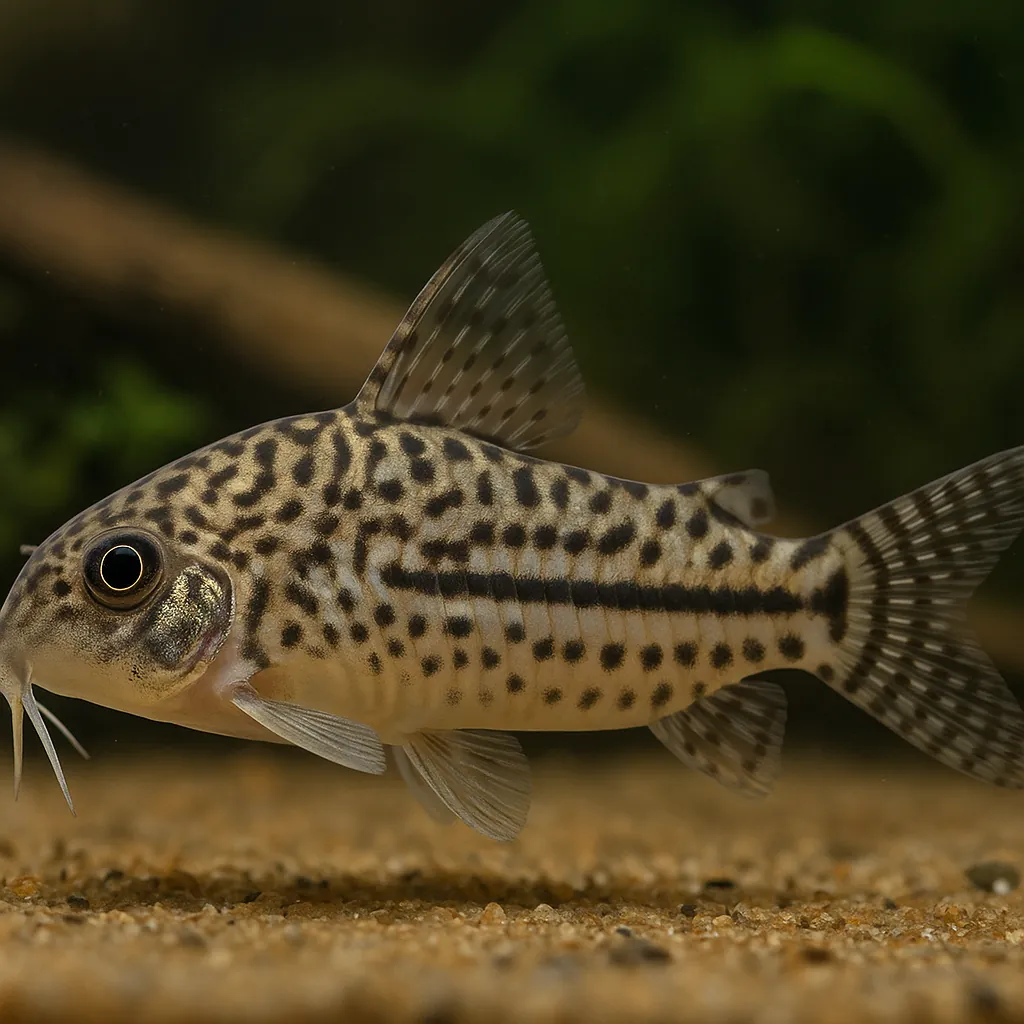
False julii cory
Introduction
The False Julii Cory (Corydoras trilineatus), also known as the Three Stripe Corydoras or Leopard Catfish, is a popular freshwater species among aquarists. Renowned for its peaceful nature and distinctive patterning, this bottom-dwelling fish adds both activity and visual appeal to community tanks. Its manageable care requirements make it an excellent choice for both novice and intermediate fishkeepers.
What makes the False Julii Cory a favorite among aquarists?
Its striking appearance, coupled with a gentle temperament and ease of care, makes it a standout addition to community aquariums.
Is the False Julii Cory suitable for beginners?
Yes, its hardy nature and straightforward care needs make it ideal for those new to fishkeeping.
Care and Environment
Providing optimal care for the False Julii Cory involves attention to tank setup, water conditions, and dietary needs.
What is the minimum tank size for a False Julii Cory?
A minimum of 15 liters is recommended for a single fish, but a larger tank is preferable for groups.
What are the ideal water parameters for this species?
Maintain a temperature between 22°C and 26°C, pH levels from 6.0 to 8.0, and water hardness between 4 to 18°N.
Filtration should be efficient to keep the water clean, and lighting can be moderate, as these fish are accustomed to shaded environments. A sandy or fine gravel substrate is ideal to protect their sensitive barbels. Decorate the tank with plants, driftwood, and caves to provide hiding spots and mimic their natural habitat.
As omnivores, False Julii Corys thrive on a varied diet. High-quality sinking pellets or wafers should form the staple, supplemented with live or frozen foods like bloodworms or brine shrimp. Feeding should occur once or twice daily, offering only what they can consume in a few minutes.
Are there any specific challenges in caring for False Julii Corys?
They are sensitive to poor water quality, so regular maintenance and monitoring are essential to prevent health issues.
Origin and Habitat
False Julii Corys are native to the central Amazon River basin in Brazil and Colombia, as well as the Peruvian Amazon. They inhabit slow-moving, well-oxygenated rivers and tributaries with soft, sandy substrates, often surrounded by dense aquatic vegetation. These environments provide ample hiding spots and foraging opportunities, contributing to their well-being.
What type of environment do False Julii Corys prefer in the wild?
They thrive in slow-moving rivers with sandy bottoms and abundant plant cover, offering both shelter and food sources.
How does their natural habitat influence their care in captivity?
Replicating similar conditions in the aquarium, such as using a sandy substrate and providing plenty of hiding places, helps them feel secure and exhibit natural behaviors.
Temperament and Compatibility
False Julii Corys are peaceful, social fish that prefer to be kept in groups of at least four to six individuals. They are bottom dwellers and coexist well with other non-aggressive species occupying different tank levels.
What are suitable tank mates for False Julii Corys?
Compatible companions include small tetras, rasboras, guppies, dwarf cichlids, and other peaceful community fish.
Are there any fish species to avoid housing with False Julii Corys?
Avoid aggressive or significantly larger species that may intimidate or harm them.
Providing a harmonious community tank with appropriate tank mates and environmental conditions will ensure the well-being and natural behavior of False Julii Corys.
Interesting Facts
False Julii Corys possess unique traits that endear them to aquarists. They have the ability to rotate their eyes, giving the appearance of winking, which adds to their charm. Additionally, their bodies are covered with overlapping armored plates called scutes, providing protection against predators and skin diseases.
How can you distinguish between a False Julii Cory and a true Julii Cory?
False Julii Corys exhibit a reticulated pattern on their heads, whereas true Julii Corys have distinct, separate spots.
What is their typical lifespan in captivity?
With proper care, False Julii Corys can live up to 7 years, making them a long-term commitment for aquarists.
Sources
All information in this article has been gathered from the following reputable sources:
Overview
Recommended Tank Size 19.8 Gallons (for groups of 6 or more) |
Minimum Group Size 4 |
Minimum Tank Volume 4 Gallons |
Maximum Adult Length 2.5 inches |
Average Adult Length 2 inches |
Shoaling (6+ required) Yes |
Preferred Water Type Freshwater, soft, slightly acidic to neutral |
Temperature Range (°C) 22–26 |
pH Range 6.0–8.0 |
Water Hardness (dGH) 4–18 |
Typical Lifespan (years) 5 years |